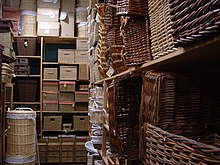This article needs additional citations for verification. (February 2008) |

A hamper refers to one of several related basket-like items.[1] In primarily British usage, it refers to a wicker basket, usually large, that is used for the transport of items, often food. In North America, the term generally refers to a household receptacle, often a basket, for clean (out of the dryer or off the line) or dirty clothing, regardless of its composition, i.e. "a laundry hamper". Typically a laundry hamper is used for storage and will be sturdier, taller and have a lid while a laundry basket is open and used mainly for transport.[2]

In agricultural use, a hamper is a wide-mouthed container of basketwork that may often be carried on the back during the harvesting of fruit or vegetables by hand by workers in the field. The contents of the hamper may be decanted regularly into larger containers or a cart, wagon, or truck.

The open ventilation and the sturdiness offered by a hamper has made it suitable for the transport of food, hence the use of the picnic hamper. A picnic hamper often has straps or storage compartments for cutlery and crockery.
At one time it was common for laundry services to leave a large basketwork container with a lid which is now commonly referred to as a clothes hamper. The same type of container would be used to return clean clothing, which would be put away by the laundry service and the empty container left in place of the full container for later pickup.[3] This type of daily or bi-daily hamper service was most common with Chinese laundry services in 19th-century England and America.
The words 'hamper' and 'hampyre' evolved as contractions of the Anglo-French hanaper, from the Medieval Latin hanaperium, which was a secure case for holding a large goblet or cup, and derived from hanapus, the Latin word for a bowl or cup. The first known usage of the word 'hamper' was in the 14th century.[4]
- ^ "Hamper". Merriam-Webster Dictionary. Merriam-Webster. Retrieved 17 January 2014.
- ^ "ORIGINS : Airing the Dirty Laundry Basket's History". Los Angeles Times. 1994-05-14. Retrieved 2020-10-08.
- ^ "LAUNDRY EXHIBITION AND IRONING COMPETITION". Leader. 1905-09-23. Retrieved 2021-10-05.
- ^ "hamper | Origin and meaning of hamper by Online Etymology Dictionary". www.etymonline.com. Retrieved 2021-10-05.